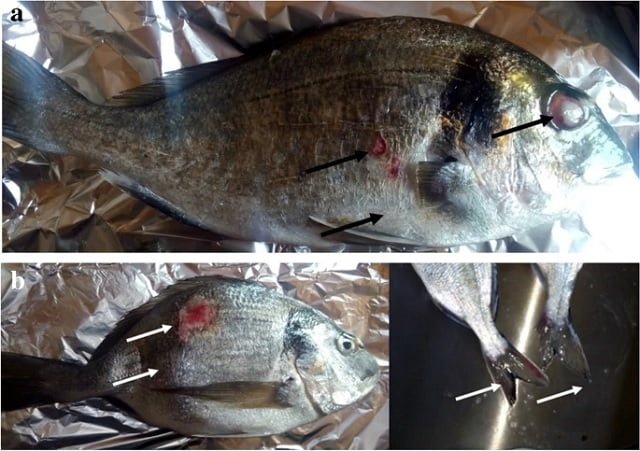
The cultivation of gilthead seabream (Sparus aurata) has gained popularity and offers a promising source of protein and economic stability. However, the rapid growth of the aquaculture industry has raised concerns about its environmental impact and the health of cultivated fish.
The intensification of aquaculture practices has led to the degradation of water quality and the emergence of new fish diseases, such as vibriosis.
A new study published by researchers from Suez Canal University, the Central Laboratory for Aquaculture Research, the Fish Farming and Technology Institute, and the National Institute of Oceanography and Fisheries (NIOF) aimed to investigate the molecular typing, prevalence, pathogenicity, and environmental risk factors associated with Vibrio campbellii (V. campbellii) in cultivated gilthead seabream.
Vibrio species are causative agents of vibriosis, a dangerous bacterial disease that can cause high mortality and significant economic losses in different aquaculture species.
Vibriosis, caused by Vibrio campbellii, is one such threat. This study delves into the intricate world of vibriosis in cultivated gilthead seabream, shedding light on its molecular characteristics, prevalence, pathogenicity, and the environmental factors contributing to its occurrence.
The study reports that vibriosis serves as a microbiological barometer of climate change, and its incidence is strongly associated with environmental conditions.
Investigating V. campbellii
Over the course of a year, researchers collected 160 gilthead seabream from private fish farms in the Suez Canal area. These fish underwent rigorous laboratory examinations, including clinical and post-mortem inspections. The results revealed signs and lesions associated with vibriosis, confirming the presence of V. campbellii in various internal organs.
Unmasking the Culprit
The identification of isolated bacteria was achieved through a combination of morphological, biochemical, and molecular techniques targeting the conserved 16S rRNA gene. Histopathological examination provided crucial information about the damage caused by the pathogen and the progression of the septicemic disease.
Seasonal Variations
The prevalence of V. campbellii showed intriguing seasonal patterns, with higher incidence rates observed during the summer months. This underscores the importance of considering seasonal parameters when assessing the prevalence and severity of vibriosis in mariculture.
Stay Always Informed
Join our communities to instantly receive the most important news, reports, and analysis from the aquaculture industry.
Water Quality as a Predictor
To gain a deeper understanding of disease dynamics, researchers turned to water quality measures. Receiver operating characteristic (ROC) curve analysis was employed to evaluate the diagnostic performance of these measures. Surprisingly, ammonia levels emerged as a significant predictor of V. campbellii prevalence, emphasizing the fundamental role of water quality in disease emergence.
Towards Sustainable Aquaculture
Challenge experiments conducted as part of this study yielded valuable insights. Control groups demonstrated a 100% survival rate, while the challenged group faced a mortality rate of 70.00 ± 2.89%. These results highlight the urgent need for comprehensive management measures to safeguard the health and well-being of aquaculture populations.
Conclusion
“In conclusion, this study provides valuable insights into the clinical, bacteriological, molecular, and histopathological aspects of V. campbellii infection in gilthead seabream,” report the authors, describing the complex interplay between environmental factors, water quality, and disease prevalence.
By unraveling the mysteries of V. campbellii in gilthead seabream aquaculture and its seasonal variations, researchers take a significant step toward the development of sustainable aquaculture practices.
As we strive to feed a growing global population, understanding and mitigating the challenges posed by diseases like vibriosis becomes essential to ensure food security and the health of our aquatic ecosystems.
Contact
Mahmoud Mabrok
Department of Fish Diseases and Management
Faculty of Veterinary Medicine, Suez Canal University
Ismailia, 41522, Egypt
Email: dr.mahmoudmabrok@yahoo.com
Reference (open access)
Aly, S.M., Elatta, M.A., ElBanna, N.I. et al. Studies on Vibrio campbellii as a newly emerging pathogen affecting cultured seabream (Sparus aurata) in Egypt. Aquacult Int (2023). https://doi.org/10.1007/s10499-023-01236-y
Editor at the digital magazine AquaHoy. He holds a degree in Aquaculture Biology from the National University of Santa (UNS) and a Master’s degree in Science and Innovation Management from the Polytechnic University of Valencia, with postgraduate diplomas in Business Innovation and Innovation Management. He possesses extensive experience in the aquaculture and fisheries sector, having led the Fisheries Innovation Unit of the National Program for Innovation in Fisheries and Aquaculture (PNIPA). He has served as a senior consultant in technology watch, an innovation project formulator and advisor, and a lecturer at UNS. He is a member of the Peruvian College of Biologists and was recognized by the World Aquaculture Society (WAS) in 2016 for his contribution to aquaculture.




